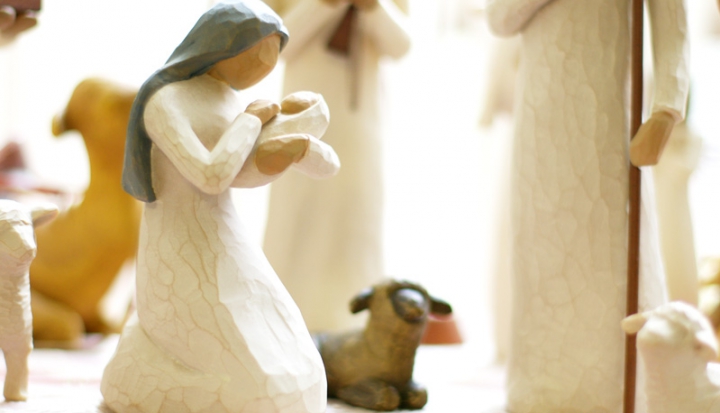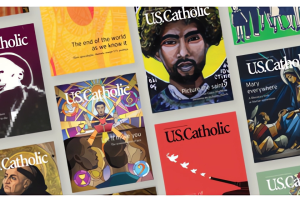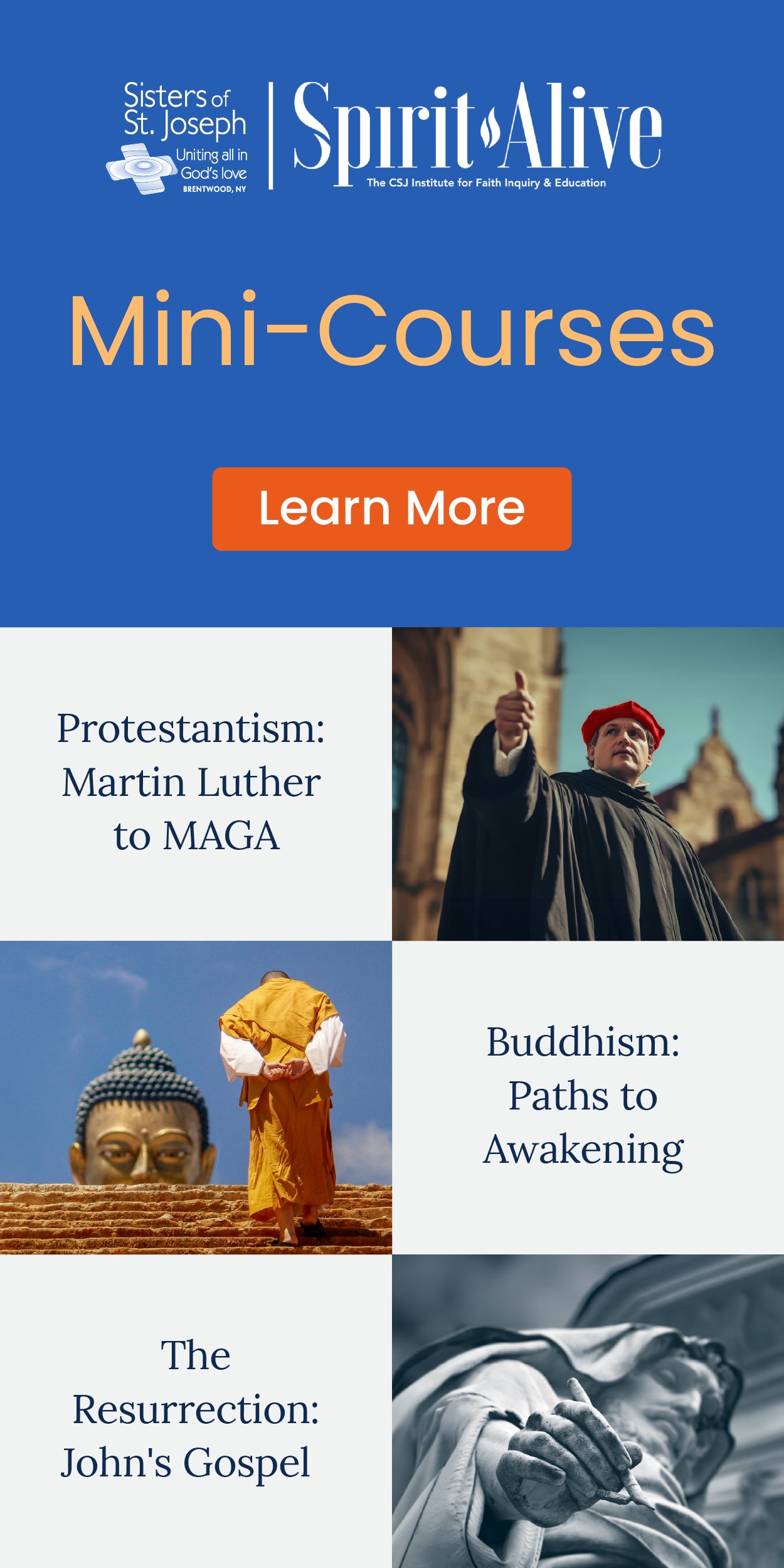There’s a commercial that I see everywhere lately. A little girl and her dad are working on a volcano for her science fair. But something goes wrong and at the last minute the volcano doesn’t explode (as a fellow procrastinator, I feel her pain). Her dad’s solution: a $1,000 flat screen television! She can just show the judges what a volcano looks like! And then, successful science fair experience behind them, the family curls up together to watch a movie. Apparently expensive tvs are good at bringing families together as well as facilitating academic success. In another Christmas commercial, this one for some luxury car, a young, handsome man shows his wife her present—a fancy SUV with a big red bow. She smiles, only to have her face immediately fall because she wanted a different expensive car.
Judge American society based on television commercials and you might get the idea that we’re a pretty frivolous bunch. Ads constantly scream, “Your child/spouse/parent/pet will only love you if you buy them the best!” Meanwhile, Syrian refugees are fleeing for their lives and being turned away from nations’ borders with nowhere to go. In Chennai, India, hundreds of people are dead and thousands have been displaced because of flooding. The terrorist attacks in Paris last month killed 129 people. It all makes all of my own problems seem pretty trivial.
That might explain why I’m having a hard time getting into the Christmas spirit this year. It doesn’t seem quite right to sit around a decorated tree in my warm apartment, drinking hot cocoa and listening to lyrics like, “O tidings of comfort and joy” or “Joy to the world.” Advent is supposed to be a time of preparation, of anticipation and excitement for the coming of Christ. But lately it feels more like the end times than the beginning of something special.
But the nativity isn’t just about the image of cherubic baby Jesus surrounded by wise men and shepherds and adorable barn animals. It’s not just about Mary, the beaming and serene mother of God. It’s not just angels crying the good news or a star beckoning the wise men as all of creation celebrates the birth of Jesus. Sure, those are all pieces of the story, but not the whole one.
No matter which narrative about the birth of Jesus you read—there’s two, one in the Gospel of Matthew and one in Luke—you get the picture that the world was a pretty scary place. The crèches we put under our Christmas trees are the sanitized version of the story.
In Luke’s story, we’re told that Mary and Joseph laid their newborn son in a manger, because there was no room for them in the inn (Luke 2:7). Imagine being Mary or Joseph in that story. First, even though Mary was nine months pregnant, they had to travel from Nazareth or Bethlehem. Now, Google Maps tells me that it will take me four hours to walk that distance, but I’m going to assume there were no paved roads back when Jesus was born. Either way, the terrain is pretty hilly, and not something I have any desire to do while I’m about to give birth. When they finally get to Bethlehem, it’s too late to go back, so they decide to spend the night in a stable. That’s where Mary goes into labor, with the sheep and the cows. And there’s nowhere to put the baby, so they make a bed out of a feed trough, which is at least conveniently full of hay.
The story reminds me of Magnus Wennman’s photo series Where the Children Sleep. In it, he documents the stories of the thousands of Syrian refugee children who are without homes or often even beds. These kids—some as young as 2 years old—are sleeping in fields and on flattened cardboard pallets. Many of them are afraid of their pillow, because they connect it to the air raids on their hometowns, which often happened at night while they were sleeping. When we look for the Christ child in our midst, here’s a good place to start.
But as sobering as Luke’s story can be, Matthew’s account is even more harrowing. Matthew tells us that those same wise men who brought the royal gifts of gold, frankincense, and myrrh were also sent by King Herod, who wanted to kill baby Jesus because he was afraid that this child would supplant his political reign. The wise men, through great courage and probably personal danger, did not tell Herod when they found Mary and Joseph, but returned home a different way. However, this didn’t stop the king.
Joseph had a dream that Herod was searching for baby Jesus to kill him. Joseph wastes no time; he wakes up, gathers his wife and child, and they flee to Egypt in the middle of the night. (I looked this journey up on Google Maps too—it would take about 125 hours. Let’s say they walked 10 hours a day—what I would guess is a pretty punishing pace with a baby—it would take them about two weeks to reach Cairo.)
Mary and Joseph were so scared for their safety that they left everything behind. They didn’t stop to say goodbye to their friends and family, they probably didn’t have time to even pack. For all they knew, they were never going to be able to return to their homes. Here’s another familiar story. Thousands and millions of refugees are currently doing exactly the same thing. They are listening to the angel that tells them to get up and pack in the middle of the night, to leave and to take their family to safety. They are risking their lives and crossing borders with infants and small children because the risk is far less than the risk if they stayed. But unlike Mary, Joseph, and Jesus, who were supposedly welcomed in Egypt, these modern refugees are facing prejudice, hunger, and internment camps. And these are the lucky ones.
Jesus and his family might have reached safety, but that doesn’t stop Herod. In his anger, he kills all the children he can find who are 2 years old or younger (Matt 2:16). Because he was afraid about who one child would grow up to be, he killed countless numbers of others. Sound applicable to our modern lives?
Christmas is supposed to be about joy, peace, and salvation, not murderous rage. It’s supposed to be about God’s love, not evil. But here, written right into the gospel, is a story about people doing horrific and unspeakable things to other people. And yet, somehow, in the midst of all the uncertainty and fear, good prevails.
This year, that is what the Christmas story is to me: the command to recognize God in the face of a helpless child and to do anything possible to protect that child. Xenophobia and religious intolerance and fear have always existed. But there have also always been people working against the evil of the world. In the nativity story, the wise men refuse to tell Herod the location of baby Jesus, protecting him as long as they can. Joseph trusts God and his family enough not only to stay with Mary when she gets miraculously pregnant, but to leave everything he knows on the word of an angel. And, of course, baby Jesus eventually grows up. But that’s a whole different story.












